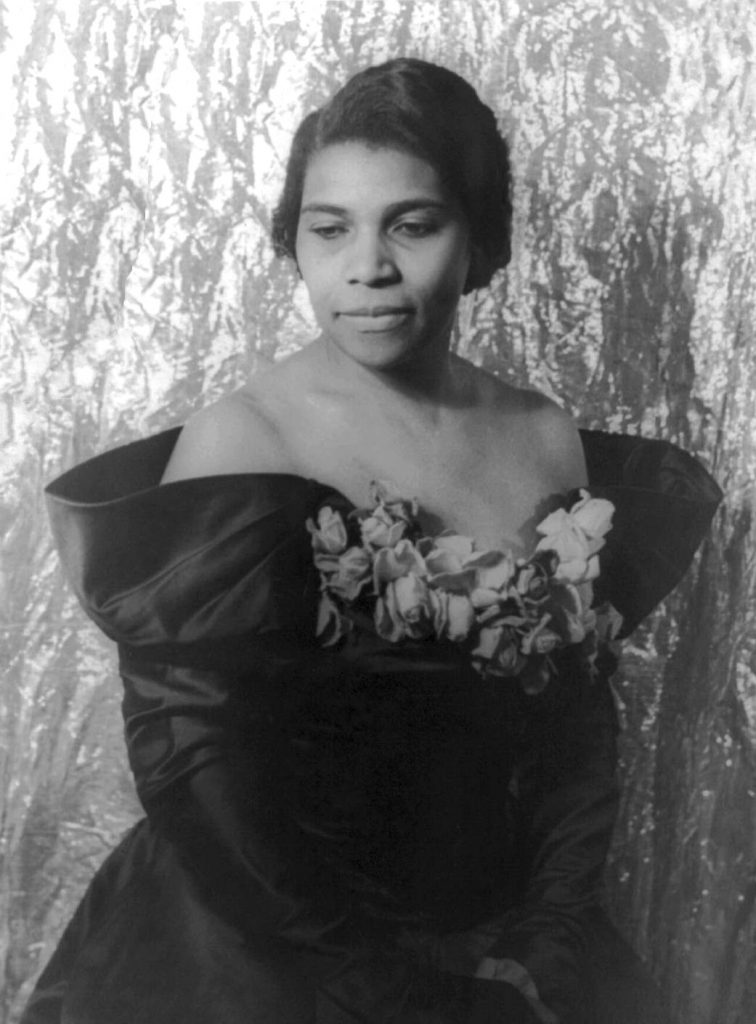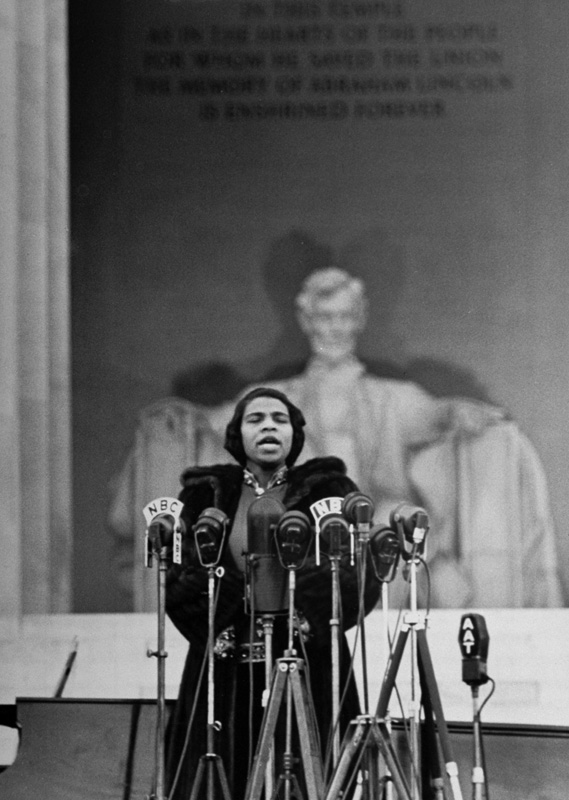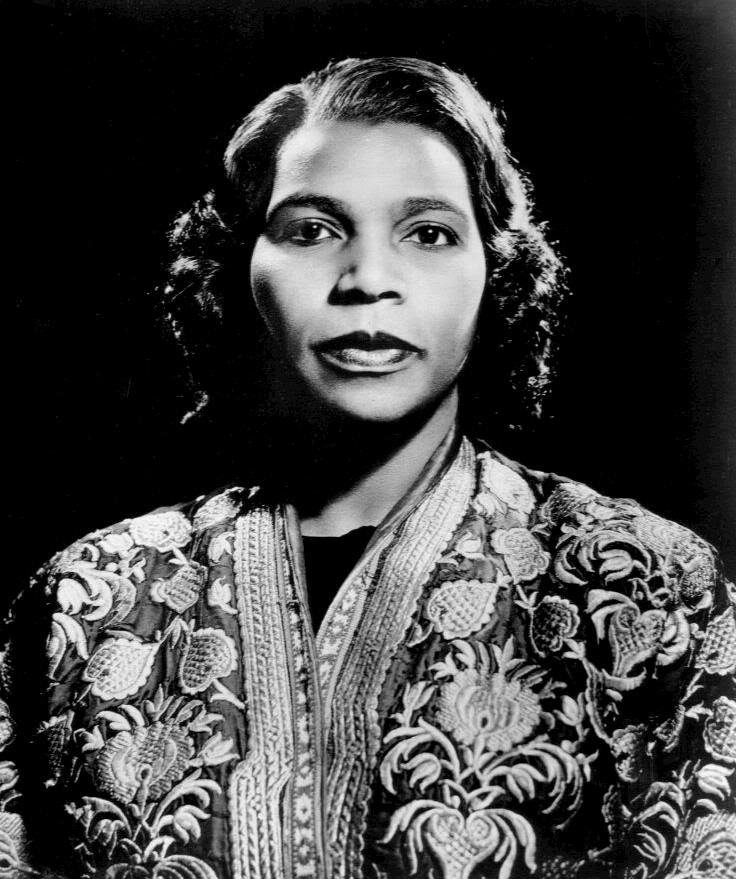TBT: Super Awesome People™ in History.
Recently, the University of Pennsylvania Libraries launched the newly-digitized (and publicly accessible) archives of Marian Anderson, the famed contralto singer who broke barriers as a Black performer throughout her decades-long career. The archives include scrapbooks, notebooks and diaries, programs, photographs, recordings, and interviews. In celebration of this new digital archive and Marian Anderson’s incredible talent, here is an introduction to the life of Marian Anderson and links to learn more about her.
“Yours is a voice such as one hears once in a hundred years.”
Italian composer Arturo Toscanini to Marian Anderson, 1935

Marian Anderson (Carl Van Vechten) 
Easter concert the Lincoln Memorial, 1939. (Thomas D. Mcavoy, Time Life Pictures/Getty Images) 
Marian Anderson, 1951 (Sol Hurok)
Marian Anderson was born in 1897 in South Philadelphia as the eldest of three daughters of a teamster and a former school teacher. She started singing at age three and joined the Union Baptist Church choir at age six. She had a strong contralto voice and three-octave range, and further impressed the choir director by learning all of the hymn parts—soprano, alto, tenor, bass—which she could sing on cue. Despite her enormous talent, Anderson didn’t receive any formal music training until she was seventeen, as she was rejected from local music schools because she was Black. Her first formal teacher was light coloratura soprano Mary Saunders Patterson who gave her lessons for free and helped Marian learn her first traditional foreign language songs.
When Anderson was still a child, her father died, and Marian helped support her family by charging small fees for her musical performances. Because of prejudice and poverty, she was unable to receive a high school education or music lessons until her church and the Black community rallied to raise funds for her education and private music lessons. She trained for two years with Agnes Reifsnyder, and then with voice teacher and tenor Giuseppe Boghetti, who remembered first meeting Marian “at the end of a long hard day, when I was weary of singing and singers, and when a tall calm girl poured out ‘Deep River’ in the twilight and made me cry.”
In 1925, Boghetti entered Anderson in a New York Philharmonic singing competition, and she won over 300 other singers. She was awarded a solo performance with the Philharmonic and sang for an audience of 7,500 at Lewisohn Stadium in New York City. But Marian’s career was stalling in the States due to discrimination and her need to master European art songs, so she headed abroad.
“Sometimes racial prejudice is like a hair across your cheek. You can’t see it, you can’t find it with your fingers, but you keep brushing it because the feel of it is irritating.”
Marian Anderson
Anderson made several European tours in the late 1920s and throughout the ’30s to study and perform. She quickly gained enormous popularity in Scandinavian countries and made her Paris debut in 1934. At the time, many people saw Europe as a “true land of racial acceptance“, but the creep of Nazism and Fascism across the continent exasperated anti-Black racism. In 1935, Marian Anderson’s petition to perform at the Salzburg Festival was rejected, but Marian performed anyway, in defiance of their prejudice. Because of increasing racial violence, many Black performers fled Europe throughout the mid-’30s, but Anderson stayed longer than most, giving the final performance of her European tour in Vienna in November 1937, just months before Hitler annexed Austria.
Although Marian returned to the States as a bonafide European celebrity, she continued to face racial discrimination. She was frequently restricted to “colored” hotels, train cars, dining rooms, and bathrooms, and was often denied service altogether. Most famously, in 1939, the Daughters of the American Revolution (DAR) refused to book her at Constitution Hall in Washington, D.C. The refusal sparked national protests, and First Lady Eleanor Roosevelt resigned from DAR for their “unfortunate” decision to discriminate against singer on the basis of race. The First Lady was an ardent supporter of Anderson, having seen Marian sing in 1936 (as the first Black American invited to perform at the White House), and she presented Marian with the NAACP’s Spingarn Award in 1938, for “highest achievement in any honorable field of endeavor”.
With the Roosevelts’ support and the help of the Secretary of the Interior, Harold Ickes, Marian Anderson performed her largest concert ever in front of the Lincoln Memorial in D.C. on Easter Sunday, 1939. In a 25-minute concert, Anderson sang patriotic, classical, and spiritual songs for a crowd of 75,000 and a live radio audience of millions. Although she did not consider herself to be a Civil Rights activist, after her world-famous performance, she became an icon for equality and Black achievement that inspired generations.
“In this great auditorium under the sky, all of us are free. Genius, like justice, is blind. Genius draws no color lines.”
Secretary of the Interior Harold Ickes, introducing Marian Anderson before her Easter Sunday concert on April 9, 1939
Marian Anderson’s career spanned decades, and she broken numerous color barriers and achieved greatness through her talent, determination, and fortitude. In 1955, she became the first Black soloist to perform on stage at the Metropolitan Opera (at age 57) when she portrayed Ulrica in the Met’s production of Un Ballo in Maschera by Giuseppe Verdi. She also served as a delegate to the United Nations Human Rights Committee and toured the world as a Goodwill Ambassador, including performing in a postwar Germany to aid the U.S. Military’s efforts to de-Nazify the country. In 1963, she sang at the March on Washington for Jobs and Freedom (again in front of the Lincoln Memorial) and was awarded the Presidential Medal of Freedom a few months later.
Over the years, Marian Anderson sang for kings and queens of Europe and at the inaugurations of two U.S. presidents (Dwight D. Eisenhower and John F. Kennedy). She received dozens of honorary degrees, she received the Congressional Gold Medal in 1977, the Kennedy Center Honors in 1978, the National Medal of Arts in 1986, and a Grammy Lifetime Achievement Award in 1991. She was inducted into the National Women’s Hall of Fame in 1973. In 2003, her performance of “He’s Got the Whole World in His Hands” was selected for the Library of Congress’s National Registry, and she was honored with a commemorative stamp by the United States Postal Service in 2005.
Marian Anderson retired in 1965 and gave her final performance at Carnegie Hall in New York. Her retirement in Danbury, Connecticut, was as unassuming and humble as she had lived much of her life. She purchased a farm with her husband, architect Orpheus Fisher (m. 1943), and they lived together at Marianna Farm until his death in 1986. Many of the documents in the University of Pennsylvania Libraries’ newly digitized archive include journals from Marian’s years at the farm where she lived a quiet life growing her own fruits and vegetables, writing about cooking, and raising puppies. She remained at Marianna until shortly before her death in 1993.
“[W]hen I sing, I don’t want them to see that my face is black; I don’t want them to see that my face is white. I want them to see my soul. And that is colorless.”
Marian Anderson (1897-1993)
Learn More About Marian Anderson:
- Discovering Marian Anderson (University of Pennsylvania Library, Digital Archives)
- Marian Anderson: A Singer’s Journey (Allan Keiler)
- Marian Anderson (1897-1993) (Afrocentric Voices in “Classical” Music)
- Marian Anderson: Musical Icon (PBS American Experience)
- When Marian Anderson Defied the Nazis (The New Yorker)
- Denied A Stage, She Sang For A Nation (NPR)
- How Marian Anderson Became an Iconic Symbol for Equality (Smithsonian Magazine)
- See Newly Digitized, Public Archives on Recitalist Marian Anderson’s Life and Work (Hyperallergic)
- Marian Anderson: Of Thee We Sing (The Kennedy Center)
- Marian Anderson Is Dead at 96; Singer Shattered Racial Barriers (The New York Times)
- Rare Voice, Gracious Neighbor (The New York Times)